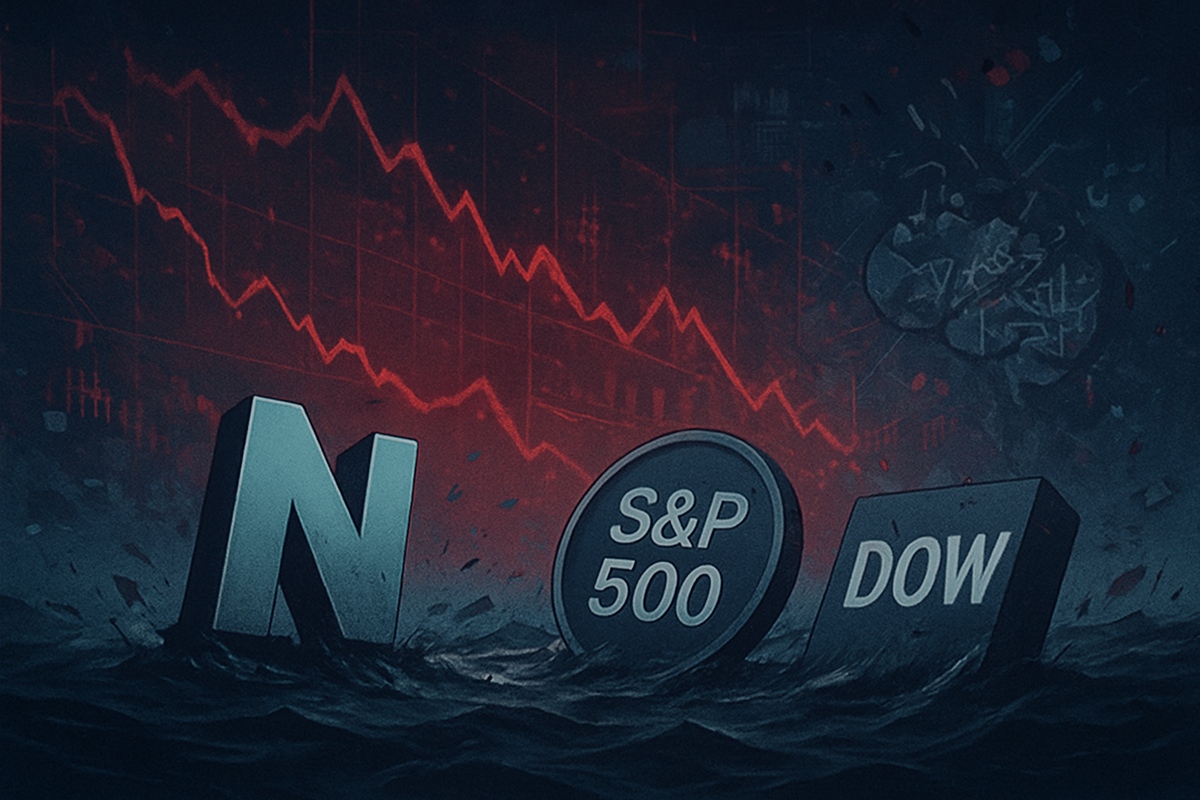
New York, NY – November 7, 2025 – The U.S. stock market has been gripped by a significant downturn in early November 2025, culminating in a brutal week that saw the Nasdaq Composite, S&P 500, and Dow Jones Industrial Average all close sharply lower. This market correction is primarily fueled by escalating investor apprehension over what many perceive as inflated valuations within the technology and artificial intelligence (AI) sectors, coupled with broader macroeconomic concerns. The tech sell-off, driven by widespread profit-taking and fears of an "AI bubble," has wiped billions from market capitalization, signaling a notable shift from unbridled optimism to cautious prudence among investors.
The immediate implications are palpable, with a discernible defensive shift as investors re-evaluate risk appetites and the sustainability of recent growth trajectories, especially those propelled by AI enthusiasm. While some analysts suggest this could lead to a rotation of funds into higher-quality tech stocks or sectors with more attractive valuations, the overall sentiment is one of uncertainty, with market participants keenly watching for signs of stabilization amidst ongoing economic headwinds.
Tech Titans Tumble: A Deep Dive into the Market's November Meltdown
As of Friday, November 7, 2025, the market turbulence intensified, marking a significant reversal from the year's earlier bullish trends. The tech-heavy Nasdaq Composite plunged 1.9% on November 7, extending its losses to mark its worst weekly performance since March. Similarly, the S&P 500 slid 1.1% to finish at 6,720.32, tracking toward its steepest weekly loss in four, while the Dow Jones Industrial Average fell 0.8% or 398.70 points to close at 46,912.30, also heading for its steepest weekly loss in four. This broad-market retreat has pushed the Nasdaq Composite below its 50-day moving average, a technical indicator often signaling a shift in momentum.
The primary catalyst for this downturn is the resurfacing of valuation concerns related to artificial intelligence (AI) stocks. Investors are actively booking profits on AI infrastructure developers due to what are widely considered "sky-high valuations" in this sector. Major tech stocks have borne the brunt of the sell-off. Nvidia (NASDAQ: NVDA) saw its shares fall significantly, dropping 3.8% on Friday and experiencing a 4% fall earlier in the week. Broadcom (NASDAQ: AVGO) fell 4.6% on Friday, adding to its weekly losses. Other key AI players like Microsoft (NASDAQ: MSFT), Advanced Micro Devices (NASDAQ: AMD), and Palantir Technologies (NYSE: PLTR) also saw notable declines. Palantir, often cited as a "poster child for expensive tech names," dropped 8% earlier in the week despite reporting strong earnings, triggering broader fears about AI sector valuations. The information technology sector and the broader semiconductor index are on track for their biggest weekly declines in seven months.
This market correction follows a largely bullish year for global equities, with the S&P 500 climbing over 16% and the Nasdaq Composite surging nearly 22% year-to-date, primarily driven by technology behemoths and the excitement surrounding AI advancements. However, concerns about "expensive equity valuations" had been resurfacing periodically throughout 2025. The turbulence gained significant momentum in early November. On November 4, the Nasdaq tumbled 1.80%, with the S&P 500 falling 1.11% and the Dow declining 0.6%. This sharp sell-off particularly impacted technology and small-cap stocks, wiping over $500 billion from leading AI chipmakers. The sell-off intensified throughout the week, fueled by a prolonged U.S. government shutdown now in its 38th day, which has limited access to crucial economic data and dented market confidence. Weak labor market data, including U.S. job cuts totaling 153,074 in October—a soaring 183% sequentially—and a decline in consumer sentiment, have further aggravated the situation. Wall Street's "fear gauge," the CBOE Volatility Index (VIX), hit its highest level in more than two weeks, reflecting heightened investor caution.
Key stakeholders involved include the "Magnificent Seven" AI-related stocks—Nvidia (NASDAQ: NVDA), Amazon (NASDAQ: AMZN), Apple (NASDAQ: AAPL), Microsoft (NASDAQ: MSFT), Tesla (NASDAQ: TSLA), Alphabet (NASDAQ: GOOGL), and Meta Platforms (NASDAQ: META)—all of which have experienced one-day falls, signaling broad pressure on the sector. Market analysts attribute the early November weakness to seasonal trends, inflated tech stock prices, and a lack of positive market catalysts. Prominent Wall Street executives have issued warnings about a potential serious market correction, with figures like Michael Burry reportedly betting against Palantir and Nvidia, further contributing to market jitters. The ongoing government shutdown has also played a critical role, limiting access to key economic data and fueling market uncertainty.
Shifting Fortunes: Who Wins and Who Loses in the Market's Rebalancing Act
The current market downturn, driven by the tech sell-off and AI valuation concerns, is creating a clear divergence in fortunes across sectors and individual companies. As investors flee perceived overvalued growth stocks, a "risk-off" environment is taking hold, leading to significant losses for some while offering resilience or even gains for others.
The primary losers in this environment are undoubtedly the technology sector, particularly companies whose valuations have soared on AI optimism. Nvidia (NASDAQ: NVDA), a bellwether for the AI chip industry, has seen its stock plummet over 16% in four trading sessions, wiping out approximately $800 billion in market value. This is attributed to valuation fatigue and concerns over U.S. export restrictions impacting sales to China. Palantir Technologies (NYSE: PLTR), despite strong earnings, saw its stock slump due to its extreme price-to-earnings ratio, which investors are now reassessing. Other "Magnificent Seven" members like Meta Platforms (NASDAQ: META), Amazon (NASDAQ: AMZN), Apple (NASDAQ: AAPL), Microsoft (NASDAQ: MSFT), Tesla (NASDAQ: TSLA), and Alphabet (NASDAQ: GOOGL) have also experienced declines, signaling broad pressure. The consumer discretionary sector is also vulnerable, with companies like DoorDash (NASDAQ: DASH) and Tapestry (NYSE: TPR) losing ground due to missed earnings expectations and forecasts, reflecting broader economic slowdown fears. Even cryptocurrencies, often correlated with tech sentiment, have suffered, with Bitcoin briefly dipping below $100,000.
Conversely, several sectors and companies are demonstrating resilience or are poised to benefit as investors seek stability and value. Defensive sectors are proving attractive. Consumer Staples, including companies like Procter & Gamble (NYSE: PG), Coca-Cola (NYSE: KO), and PepsiCo (NASDAQ: PEP), are seen as stable due to consistent demand for essential goods. The Healthcare sector, with its long-term growth drivers and generally lower valuations, offers defensive plays through companies like Johnson & Johnson (NYSE: JNJ) and Pfizer (NYSE: PFE). Utilities, such as NextEra Energy (NYSE: NEE), are also favored for their steady demand and potential tailwinds from AI-driven power consumption. Defense stocks (Aerospace & Defense), like Boeing (NYSE: BA) and Archer Aviation (NYSE: ACHR), are viewed as relatively defensive due to stable government spending. The Financials sector could benefit from diversification away from tech and potential shifts in monetary policy. The Energy sector is performing relatively better, supported by a gradual recovery in oil prices. Even within tech, established companies with tangible AI monetization strategies are showing resilience. Microsoft (NASDAQ: MSFT) and Amazon (NASDAQ: AMZN), through their cloud platforms Azure and AWS, are delivering cash-backed growth in cloud and AI services. Oracle (NYSE: ORCL) has seen a substantial increase in its order book related to data center operations for AI players. Furthermore, select semiconductor companies focused on foundational AI infrastructure, such as SK Hynix (KRX: 000660) and Samsung Electronics (KRX: 005930), are thriving due to robust demand for high-bandwidth memory (HBM3E) chips crucial for AI GPUs.
A Broader Lens: Unpacking the Market's Deeper Implications
The November 2025 stock market downturn, particularly the tech sell-off, carries significant wider implications, signaling a crucial moment for the broader financial landscape. This event underscores a shift in industry trends, moving away from speculative growth towards a greater emphasis on profitability, sustainable business models, and reasonable valuations. Companies are now compelled to recalibrate strategies, prioritizing financial discipline and demonstrable returns over aggressive growth projections fueled by speculative enthusiasm. The market's sensitivity to perceived setbacks in the AI sector highlights the intricate relationship between technological innovation and investment, where valuations can sometimes detach from fundamental realities.
The ripple effects of this downturn are multifaceted. Smaller tech companies and startups, especially those without established revenue streams, face immense pressure, potentially finding it harder to secure funding as venture capital firms become more risk-averse. This could lead to a tougher fundraising environment and potentially reinforce the dominance of larger, more well-capitalized tech firms. Conversely, financially strong tech giants might find acquisition targets more affordable, looking to expand their AI capabilities or market share. A significant correction in major tech stocks could also impact broader consumer confidence due to widespread ownership of these stocks in retirement portfolios, potentially leading to reduced consumer spending and exacerbating any economic slowdowns.
From a regulatory and policy perspective, a stock market downturn and tech sell-off would likely draw increased scrutiny. Concerns over market concentration and potential "AI bubbles" could prompt financial regulators to consider new policies aimed at ensuring fair competition, data privacy, and ethical AI development. Central banks, in the face of a significant downturn, might consider interventions, such as quantitative easing or reductions in key interest rates, to revive the economy and stabilize markets. However, detecting and deflating financial bubbles is notoriously difficult, and using monetary policy to restrain investor exuberance can have broad, unintended consequences. Policymakers would also aim to mitigate systemic vulnerabilities through capital buffers, leverage limits, and stress testing to prevent financial contagion.
Historically, the current tech sell-off draws strong parallels to the Dot-Com Bubble of the late 1990s and early 2000s. That era was characterized by extravagant valuations in tech companies often based on speculation rather than fundamentals. When the bubble burst in March 2000, the Nasdaq lost a significant portion of its value, leading to widespread bankruptcies. While today's dominant tech companies generally possess stronger fundamentals and more established revenue streams, the rapid surge in AI valuations and the subsequent profit-taking echo the speculative fervor of that period. Other comparisons include the 2008 Financial Crisis, which demonstrated how a shock in one sector can create widespread economic disruption, and the COVID-19 Market Crash (2020), which highlighted how quickly markets can react to uncertainty and how government policies can be deployed to stabilize them. This event also fits into the pattern of general market corrections, which are common and often signal a "risk-off" mentality among investors, frequently impacting high-valuation tech stocks most severely.
The Road Ahead: Navigating Volatility and Unearthing Opportunities
The stock market, following the early November 2025 tech sell-off, stands at a critical juncture, balancing the inherent long-term growth potential of technology and AI with immediate concerns about valuations and economic stability. Both short-term volatility and long-term strategic shifts are on the horizon for companies and investors alike.
In the short term, continued market volatility is highly probable, with analysts anticipating further pullbacks before year-end. This period will likely be characterized by intensified profit-taking in high-flying tech and AI stocks, and a sustained sector rotation as investors shift capital towards more undervalued and stable sectors such as healthcare, utilities, consumer staples, and energy. The ongoing U.S. government shutdown, by limiting access to official economic data, will continue to fuel market susceptibility to volatility, while persistent concerns about a weakening labor market and inflation will keep the Federal Reserve's interest rate policy under intense scrutiny. The growing debate around an "AI bubble" will also lead to increased scrutiny of AI companies' monetization strategies and financial fundamentals.
Looking at the long term, the outlook for the technology sector remains broadly optimistic, albeit with a more discerning approach to investing. Continuous innovation, digitization, and automation are expected to drive sustained growth, with AI still regarded as a significant catalyst, particularly for semiconductor and hardware companies supporting AI infrastructure. Many strategists view the current sell-off as a "healthy pullback" within a broader, multi-year secular bull market, representing a crucial maturation phase for the AI industry that shifts focus from speculative growth to fundamental financial realities. The market's emphasis is expected to pivot from the sheer "buildout" of AI infrastructure to a broader rollout of AI applications and their demonstrable monetization.
For companies, strategic pivots will be essential. This includes a renewed focus on return on investment (ROI), building resilient business models, fostering adaptability and continuous learning among employees, and embracing technology for efficiency. Robust market research, customer feedback integration, resilient financial planning, and strategic partnerships will be critical for navigating the evolving landscape. For investors, diversification across various sectors, active sector rotation, and a disciplined approach to value investing will be paramount. The sell-off may present attractive buying opportunities for long-term investors in high-quality tech stocks at discounted valuations, while exploring alternative investments like large-cap dividend stocks, gold, and real estate can help mitigate portfolio volatility.
Market opportunities will emerge in undervalued sectors such as communications (e.g., Alphabet (NASDAQ: GOOGL) and Meta (NASDAQ: META)), real estate, and energy. Small-cap and international stocks may also present opportunities as investors reallocate away from the U.S. mega-cap tech focus. Challenges include persistent overvaluation concerns in certain tech and AI stocks, ongoing economic uncertainty, potential regulatory scrutiny on anti-competitive practices, and the systemic risks associated with market concentration in a few mega-cap tech firms. Potential scenarios range from a moderate correction followed by a resumption of growth to a deeper, prolonged downturn if the "AI bubble" bursts disorderly. A less likely, but possible, short-term "melt-up" driven by retail demand also exists.
The Reckoning: Key Takeaways and the Path Forward
The early November 2025 stock market downturn, particularly the sharp tech sell-off, serves as a significant recalibration for investors and the broader financial ecosystem. The key takeaway is a stark reminder of the market's sensitivity to inflated valuations, especially in high-growth, speculative sectors like artificial intelligence. The rapid unraveling of gains in leading tech stocks underscores that even the most innovative companies are not immune to fundamental scrutiny and profit-taking when valuations stretch beyond sustainable levels. The ongoing U.S. government shutdown has exacerbated this uncertainty, highlighting the critical role of clear economic signals in maintaining investor confidence.
Moving forward, the market is poised for a period of continued volatility and re-evaluation. While the long-term potential of technology and AI remains robust, the immediate future will likely see investors prioritize companies with strong fundamentals, clear paths to profitability, and resilient business models over those solely driven by speculative growth narratives. This shift could lead to a broader market, with capital flowing into traditionally defensive sectors and undervalued assets. The strengthening of the U.S. dollar as a safe-haven asset and the rally in gold prices further suggest an underlying investor wariness about global risks, including geopolitical tensions and U.S. debt sustainability, persisting despite earlier market optimism.
The lasting impact of this event could be a more disciplined approach to investing, fostering a healthier market environment where growth is more closely tied to tangible earnings and innovation rather than pure speculation. It may also accelerate the maturation of the AI industry, shifting focus from the initial "buildout" phase to the crucial stage of demonstrating widespread application and monetization.
Investors in the coming months should closely monitor several critical factors: the resolution of the U.S. government shutdown, which would restore the flow of essential economic data; the Federal Reserve's monetary policy decisions regarding interest rates, which will profoundly influence borrowing costs and investment flows; and key inflation and labor market data, providing clues about the broader economic trajectory. Corporate earnings reports and guidance, especially from tech companies, will be crucial for assessing fundamental health. Furthermore, ongoing geopolitical developments and the performance of the AI sector, looking for signs of sustainable growth and more reasonable valuations, will be vital. Finally, the substantial $7 trillion currently residing in money market funds represents a significant pool of capital that could re-enter the stock market if interest rates decline further, offering a potential catalyst for future rallies. Staying balanced, diversified, and adaptable will be paramount for navigating the evolving market landscape.
This content is intended for informational purposes only and is not financial advice







